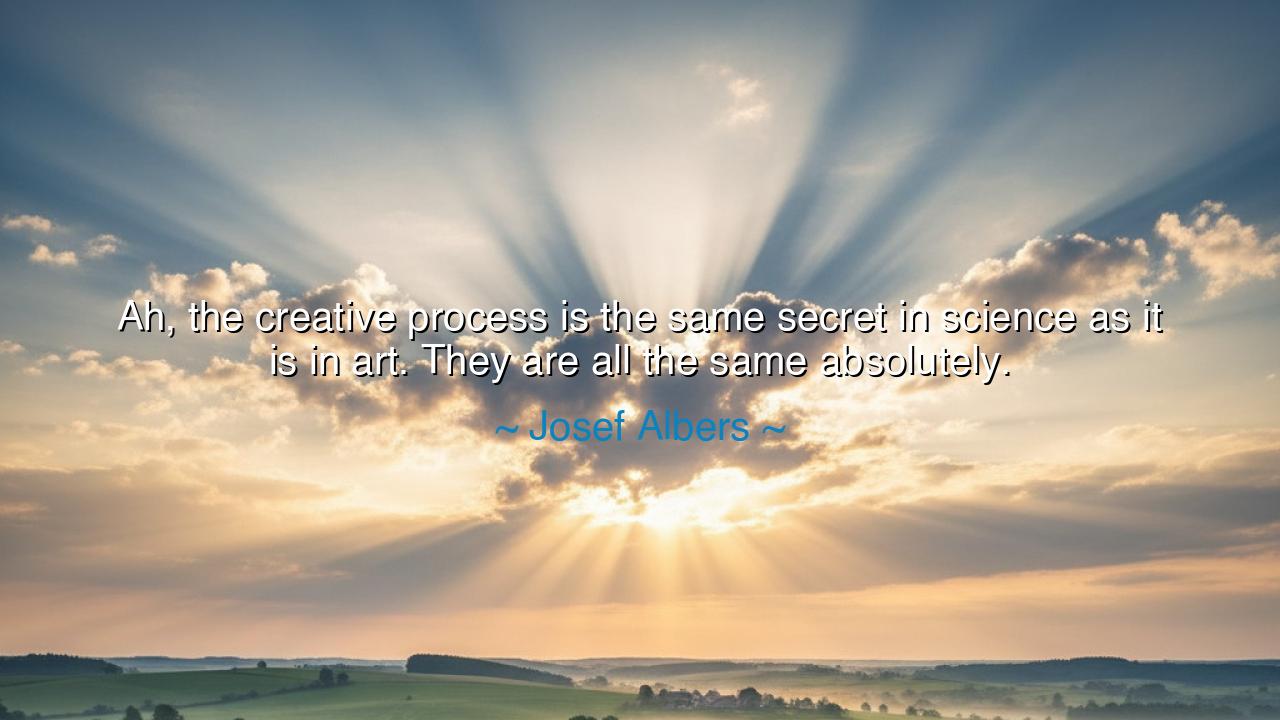
Ah, the creative process is the same secret in science as it is
Ah, the creative process is the same secret in science as it is in art. They are all the same absolutely.






"Ah, the creative process is the same secret in science as it is in art. They are all the same absolutely." These words from Josef Albers carry a timeless truth that echoes through the ages: the essence of creativity is universal. Whether we are working in science or art, the process of creation—the spark of inspiration, the struggle, the exploration, and the discovery—remains fundamentally the same. Albers tells us that the act of creation is a mystery that transcends disciplines, a secret that binds together the worlds of the artist and the scientist, the dreamer and the doer. The heart of the creative process beats with the same rhythm, no matter whether we are painting on canvas, writing symphonies, or uncovering the laws of the universe.
In the ancient world, the pursuit of knowledge was seen as a form of art. Plato and Aristotle both believed that the highest form of knowledge was not merely to accumulate facts, but to engage with the world in a creative and intuitive way. For them, the act of learning was akin to creating, and both science and art were understood as ways of shaping the world with one’s mind and soul. Plato’s belief in the ideal forms suggested that the artist and the scientist alike sought to uncover the truth hidden beneath appearances. In this view, both creation and discovery required a kind of visionary effort, where the mind reached beyond the visible world into a realm of ideas and possibilities.
The great Leonardo da Vinci, a polymath who blurred the lines between art and science, embodied this truth. In his notebooks, he meticulously sketched both anatomical drawings and machines, seeing them not as separate pursuits, but as expressions of the same underlying creative process. For Leonardo, the act of creation was a way of understanding the world—whether through the strokes of his brush or the equations of his machines. His famous paintings, like The Last Supper and Mona Lisa, were not merely visual representations; they were insights into the very nature of human emotion and form. He saw art and science as intertwined expressions of the same human drive—to understand, to discover, and to create.
In more recent history, figures like Albert Einstein have shown us that the creative process in science is much like that of an artist. Einstein once said, "Imagination is more important than knowledge." This speaks to the very heart of Albers’ point. When Einstein formulated his theory of relativity, he did not merely apply logic and reasoning; he engaged his imagination. He visualized what was impossible to see, creating new ways of thinking about space and time. The creative process, as Einstein knew, is not just about following rules—it’s about seeing things in new ways, about finding connections where none seemed to exist. The same creativity that drives an artist to see the world in vivid colors drives the scientist to imagine the universe in new dimensions.
In art, the process of creation also follows a similar path of exploration. Vincent van Gogh, though plagued by personal struggles, expressed through his paintings a deep connection to the world around him. His use of color and brushstroke reflected not just his view of the physical world, but his internal emotions and insights. For van Gogh, art was not a mere reflection of reality; it was a way of understanding and expressing the truth of human experience. His creativity was boundless, as he pushed the boundaries of what was considered acceptable in his time, much like Einstein did with the laws of physics. In this way, art and science converge, each pushing beyond what is known into the realm of the unknown, the unseen, and the unspoken.
The lesson we must draw from Albers’ insight is that creativity in any form—whether in the laboratory, on the canvas, or in life itself—requires a deep openness to the unknown. To be truly creative is to embrace the uncertainty of the process, to dive into the mystery without a guaranteed outcome, trusting that the act of creation itself will lead us to new truths. Science and art are not just about the end result, but about the journey of discovery, the courage to explore new realms, and the willingness to be moved by inspiration. Whether we are devising a new theory or composing a symphony, we are engaging with the same creative force—the desire to understand, to express, and to share our vision with the world.
In your own life, seek to embrace creativity in all its forms. Do not separate science and art as distinct or unrelated endeavors, but recognize that both are pathways to discovery. Whether you are working on a scientific problem, creating a piece of art, or simply navigating the complexities of life, approach each with the same openness and curiosity. Let the process of creation be not just a task, but a journey—one that pushes the boundaries of your understanding, that challenges the limits of what you think is possible, and that reveals the deeper truths of existence. Albers calls us to recognize that the secret of creativity lies not in rigid formulas or predefined outcomes, but in the freedom to explore, to imagine, and to create without boundaries. Let your mind be open, your spirit free, and your creativity boundless.






AAdministratorAdministrator
Welcome, honored guests. Please leave a comment, we will respond soon